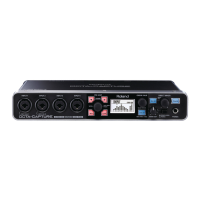90
Problem What to check Page
Can’t play or record
Could the computer to which the OCTA-CAPTURE is connected have entered
standby (suspend) mode, hibernate mode, or sleep mode?
Close all software that uses the OCTA-CAPTURE, disconnect the OCTA-
CAPTURE’s USB cable, and then reconnect it.
If this does not solve the problem, restart your computer.
–
Could you have disconnected and reconnected the USB cable while using the
OCTA-CAPTURE?
Close all software that uses the OCTA-CAPTURE, disconnect the OCTA-
CAPTURE’s USB cable, and then reconnect it.
If this does not solve the problem, restart your computer.
–
Could you have connected or disconnected the USB cable during playback or
recording, or switched o the OCTA-CAPTURE, then turned it back on again?
If you disconnect and reconnect the USB cable during playback or recording, or
switch o the OCTA-CAPTURE, then turn it back on again, the OCTA-CAPTURE
may become unable to play back or record. Stop playback or recording, and
then perform playback and recording again.
If you are still unable to play back or record, close all applications that are using
the OCTA-CAPTURE, and then turn the OCTA-CAPTURE’s power o, then on
again.
–
Could the OCTA-CAPTURE have been connected when the computer started
up?
On some computers, the OCTA-CAPTURE may be unusable if it is already
connected when the computer starts up.
Start up your computer, and then connect the OCTA-CAPTURE.
–
Try adjusting the audio buer size of the driver
If the size of the driver’s audio buer is too small, sound may not be produced,
or it may be impossible to carry out normal playback and recording.
In such cases, you should refer to “Driver Settings” (p. 69), and increase the size of
the buer.
p. 69
Could there have been a heavy processing load while using the OCTA-
CAPTURE?
If your computer experiences a heavy processing load while you’re using the
OCTA-CAPTURE, it may stop operating correctly. If this occurs, stop playback/
recording, and then perform playback/ recording again.
If you are still unable to play back or record, close all applications that are using
the OCTA-CAPTURE, and then turn the OCTA-CAPTURE’s power o, then on
again.
–
Can’t play or record
24-bit audio data
Does your software support 24-bit audio data?
Check whether the software you’re using supports playback and recording of
24-bit audio data.
–
Is your software set correctly?
Make sure that your software is set to play and record 24-bit audio data.
–

